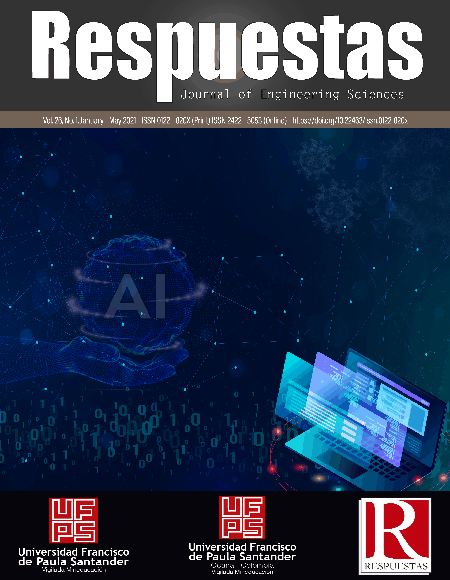Analysis and graphic estimation of the behavior of COVID-19 in Colombia, Santa Marta and Cartagena focused on lethality.
Análisis y estimación gráfica del comportamiento del COVID-19 en Colombia, Santa Marta y Cartagena enfocado a la letalidad
Main Article Content
This document presents the analysis of the behavior of daily cases of contagion and deaths from COVID-19. This is carried out to demonstrate the advance of the pandemic from its beginnings and to estimate the impact of this soon of so that health entities are prepared to execute mitigation and containment plans in the population. To achieve its realization, the method of Polynomial Regression and Normal Distribution was used. The results obtained are the curve that models the behavior of cases of contagion and death from the beginning and the prediction of how this will proceed until the end of 2020. The estimation charts model the behavior of COVID-19 based on its ideal procedure.
Downloads
Article Details
M. Á. S. Valdés, “Infección respiratoria aguda por COVID-19: una amenaza evidente”, Revista Habanera de Ciencias Médicas, vol. 19, nº 1, febrero 2020.
B. NEWS, “Coronavirus: ¿Qué hizo China con respecto al brote temprano?”. 9 junio 2020. [Online]. Disponible en: https://www.bbc.com/news/world-52573137.
E. ESPECTADOR, Redacción Internacional, “América Latina: los retos en seguridad en tiempos de crisis”, 22 noviembre 2020. [Online]. Disponible en: https://www.elespectador.com/noticias/el-mundo/america-latina-los-retos-en-seguridad-en-tiempos-de-crisis/.
L. D. Acosta, “Capacidad de respuesta frente a la pandemia de COVID-19 en América Latina y el Caribe”, Revista Panamericana de Salud Pública, vol. 44, nº e109, septiembre 2020.
D. Rosselli, “Covid-19 en Colombia: los primeros 90 días”, Acta Neurológica Colombiana, vol. 36, nº 1, mayo 2020.
Statista, Abigail Orús, “Número de personas fallecidas a causa del coronavirus en el mundo a fecha de 23 de noviembre de 2020, por país”,23 noviembre 2020. [Online]. Disponible en: https://es.statista.com/estadisticas/1095779/numero-de-muertes-causadas-por-el-coronavirus-de-wuhan-por-pais/.
Centro Internacional sobre el envejecimiento, Juan Tomás Martín,” Europa se tiñe de gris”, 9 noviembre 2018. [Online]. Disponible en: https://cenie.eu/es/blog/europa-se-tine-de-gris. [Último acceso: 23 noviembre 2020].
et al., “Preparación y control de la enfermedad por coronavirus 2019 (COVID-19) en América Latina”, Acta Médica Peruana, vol. 37, nº 1, marzo 2020.
et al., «Encajando el puzle: Una estimación rápida del número de infectados por COVID-19 en España a partir de fuentes indirectas,» Documentos de trabajo (FEDEA), nº 5, 2020.
arXiv, H. C., D. I., Y. W.Y., “Contact Tracing Mobile Apps for COVID-19: Privacy Considerations and Related Trade-offs”, 30 Marzo 2020. [Online]. Disponible en: https://arxiv.org/abs/2003.11511.
E. NOTICIA, “Investigadores desarrollan una app que predice la evolución del coronavirus los próximos tres días”, 04 abril 2020. [Online]. Disponible en: https://www.20minutos.es/noticia/4216598/0/investigadores-desarrollan-app-predice-. evolucion-coronavirus-proximos-tres-dias/?autoref=true.
D. M. López, “Uso de tecnologías en el lugar de atención para el manejo de la pandemia por COVID-19 en Colombia”, Revista Panamericana de Salud Pública, vol. 44, nº e97, agosto 2020.
Instituto Nacional de Salud, et al., “Modelo de Transmisión del Coronavirus COVID-19”, 22 abril 2020. [Online]. Disponible en: https://www.ins.gov.co/Direcciones/ONS/SiteAssets/Modelo%20COVID-19%20Colombia%20INS_v5.pdf.
W. C. M. S. M. Gabriel Chanchí Golondrino, «Aplicación de la regresión polinomial para la caracterización de la curva del COVID-19, mediante técnicas de machine learning,» Investigación e Innovación en Ingenierías, vol. 8, nº 2, 2020.
MATLAB Central File Exchange, C. Tapia, “APP de COVID 19 con MATLAB”, febrero 2020. [Online]. Disponible en: https://la.mathworks.com/matlabcentral/fileexchange/75152-app-de-covid-19-con-matlab.
OpenStreetMap Contributors, et al., “The Coronavirus App”, Open Database License, 2020. [Online]. Disponible en: https://coronavirus.app/map.
Instituto Nacional de Salud, «INS», 2020. [Online]. Disponible en: https://www.ins.gov.co/Noticias/Paginas/coronavirus-casos.aspx.
Organización Panamericana de la salud, “COVID-19 Y LA IMPORTANCIA DE FORTALECER LOS SISTEMAS DE INFORMACIÓN”, 2020. [Online]. Disponible en: https://iris.paho.org/bitstream/handle/10665.2/52128/COVID-19FactsheetIS4H_spa.pdf?sequence=14&isAllowed=y.
ABC Sociedad, L.A., “El coronavirus, comparado con las pandemias más letales de la historia”, 14 abril 2020. [Online]. Disponible en: https://www.abc.es/sociedad/abci-coronavirus-no-lejos-peor-epidemias-mas-letales-historia-202003201350_noticia.html.
et al., “COVID-19 in Colombia endpoints. Are we different, like Europe?”, Research in Social and Administrative Pharmacy, vol. 17, nº 1, enero 2021.
M. A. V. K. H. Antonio J Bravo, «Modelos matemáticos estimadores de la infección por COVID-19: Consideraciones esenciales y proyecciones en Colombia,» Revistas de Salud Pública, vol. 22, nº 3, mayo 2020.
Universitat de Barcelona, “TÉCNICAS DE PREDICCIÓN”, 2020. [Online]. Disponible en: http://www.ub.edu/aplica_infor/spss/cap8-5.htm.
G. M. Reyes, “La función de probabilidad normal: Características y aplicaciones”, eXtoikos, nº 6, 2012.
Ministerio de Salud y Protección Social Colombiano, “Datos Abiertos”,2020. [Online]. Disponible en: https://www.datos.gov.co/Salud-y-Protecci-n-Social/Casos-positivos-de-COVID-19-en-Colombia/gt2j-8ykr/data.
J. D. S, “LA DISTRIBUCIÓN NORMAL”, Revista Chilena de Anestesia, vol. 43, nº 2, 2014.
J. A. Rodrigo, “Métodos de regresión no lineal: regresión polinómica, regression splines, smooth splines y GAMs”, febrero 2017 [Online]. Disponible en: https://www.cienciadedatos.net/documentos/32_metodos_de_regresion_no_lineal_polinomica_splines_gams.
H. J. M. L. A. Ransnas, “Fitting curves to data using nonlinear regression: a practical and nonmathematical review”, The FASEB Journal, vol. 1, nº 5, 1987.
I. © The MathWorks, “polyfit”, MathWorks, 2005. [Online]. Disponible en: https://la.mathworks.com/help/matlab/ref/polyfit.html.
R. Ferrer, “Pandemia por COVID-19: el mayor reto de la historia del intensivismo”, ScienceDirect, vol. 44, nº 6, pp. 323-324, 2020.
L. S.-C. N. T. María Cecilia Johnson, “Emociones, preocupaciones y reflexiones frente a la pandemia del COVID-19 en Argentina”, SciELO, vol. 25, p. 2447-2456, 2020.




 Perfil Google Scholar
Perfil Google Scholar



